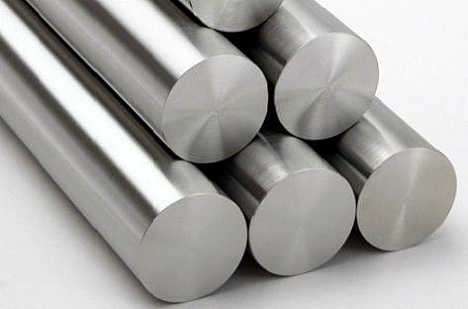The wonders of titanium
Publication Time:
2019/12/20
Titanium's wonders are mainly reflected in its properties at ultra-low temperatures, where it becomes harder and exhibits superconducting properties, unlike steel which becomes brittle and weak. Its specific gravity is only half that of iron, yet it withstands hammering and drawing like copper.
Titanium has strong resistance to acid and alkali corrosion. It remains uncorroded after 5 years of immersion in seawater, unlike steel which corrodes and deteriorates in seawater. Titanium alloy hulls for ships are impervious to seawater corrosion. Titanium alloy submarines can dive to depths of 4500 meters, while ordinary steel submarines are easily crushed by water pressure at depths exceeding 300 meters.
Titanium aircraft are strong and lightweight. A large titanium airliner can carry over 100 more passengers than a similarly weighted conventional aircraft, and can reach speeds exceeding 3000 kilometers per hour, compared to 2400 kilometers per hour for aluminum alloy aircraft.
Utilizing titanium and zirconium's strong absorption of air, it's possible to remove air and create a vacuum. Vacuum pumps made of titanium-zirconium alloys can evacuate air to one billionth of its original pressure.
In aerospace, titanium can be used to create spacecraft 'outer shells' to protect against high temperatures.
An alloy of titanium and nickel is known as 'shape memory alloy'. This alloy, after being formed into a predetermined shape and set, can recover its original form with slight heating if deformed by external forces. This alloy is currently used in many fields. Titanium carbide (TiC) resembles iron carbide, possessing a metallic luster. However, it has a higher melting point and hardness than iron carbide, making it practically valuable.
Food stored in titanium containers retains its color, aroma, and flavor for a longer time. Titanium cookware is lightweight and rust-proof, making it scientifically hygienic.
High-pressure containers made of titanium alloy can withstand pressures of 2500 atmospheres.
Titanium's applications in surgical procedures are also fascinating. Currently, stainless steel is used for bone grafting, but it has the drawback of requiring removal after bone healing, which is painful. Otherwise, rusting can harm the body. Using titanium 'artificial bones' would revolutionize orthopedics. In damaged areas of the head, titanium plates and screws are used; after a few months, bone regrows into the small holes and screws, and new muscle fibers envelop the titanium plates. The titanium bone structure connects with flesh and blood like real bone, providing support and reinforcement. Therefore, titanium is praised as a 'biocompatible metal'. It is now used in knee, shoulder, rib, skull joints, heart valves, and bone fixation clips, etc.
In steelmaking, small amounts of titanium are excellent deoxidizers, denitrifiers, and desulfurizers.
Barium titanate crystals are widely used in ultrasonic instruments and underwater detectors. This is because when their shape changes under pressure, they generate an electric current; conversely, applying an electric current changes their shape. When placed in ultrasound, barium titanate generates a current under pressure, and the magnitude of the current indicates the strength of the ultrasound. Conversely, passing a high-frequency current through it generates ultrasound.
In gold-plated crafts and daily necessities, the low hardness and susceptibility to piercing and wear of gold limit its durability. When a layer of titanium nitride is plated onto these materials, the appearance is almost identical to gold plating, but it is more wear-resistant than gold and hard alloys. This coating is praised for its 'imperishable' nature.
Organic titanium polymers can be used as surfactants, dispersants, water repellents, or rust inhibitors.
Among the four series of hydrogen storage metals currently used by humans, titanium-based alloys are one type and relatively inexpensive. However, a more ideal 'hydrogen storage metal' has not yet been found. Once this problem is solved, hydrogen can be used as fuel.

Next Page
Next Page:
Related Blog
2022 Hazardous Waste Disposal Information (Public Notice)
Company's 2022 Hazardous Waste Disposal Information (Public Notice)
2023-09-08
What are the different classifications of titanium alloys?
By utilizing the different characteristics of the two structures mentioned above, titanium alloys with different microstructures are obtained by adding appropriate alloying elements to gradually change the phase transformation temperature and phase content. At room temperature, titanium alloys have three basic matrix structures, and titanium alloys are divided into the following three categories: α alloys, (α+β) alloys, and β alloys. China represents them as TA, TC, and TB respectively. It is a single-phase alloy composed of an α-phase solid solution. Whether at normal temperature or at higher practical application temperatures, it is always in the α phase, with stable microstructure, higher wear resistance than pure titanium, and strong oxidation resistance. At 500℃~
2020-01-19
Analysis of the titanium application in China's chemical industry
In the coming years, the mainland China titanium market for chemical applications will continue to dominate the mainland China titanium market, with very broad prospects. In the past nine years, the amount of titanium used in mainland China's chemical industry has been approximately 70,000 tons, slightly higher than the sum of mainland China's titanium production in 2009 and 2010. According to him, the main applications of titanium in China's chemical industry include chlor-alkali, soda ash, vacuum salt making, petrochemical fibers, fine chemicals, and inorganic salts. The main user of titanium in the chemical industry is the chlor-alkali industry, where titanium equipment and pipes account for almost a quarter of its weight. Based on a calculation of approximately 6 tons of titanium used per 10,000-ton unit, the projected new production capacity of ion-membrane caustic soda in 2011 is 6 million tons, with an estimated titanium consumption of 36 million tons. The projected increase in production capacity in 2012 is 200 tons, with a titanium consumption of 1,200 tons.
2019-12-20
Titanium's remarkable properties are primarily demonstrated in its behavior at ultra-low temperatures, where it becomes even harder and exhibits superconducting properties, unlike steel which becomes brittle and ineffective. Its specific gravity is only half that of iron, yet it withstands hammering and drawing like copper. Titanium possesses strong resistance to acid and alkali corrosion; it remains uncorroded after five years of immersion in seawater, whereas steel corrodes and deteriorates under the same conditions. Titanium alloy hulls for ships are impervious to seawater corrosion. 'Titanium submarines,' constructed from titanium alloys, can dive to depths of 4500 meters, while ordinary steel submarines are easily crushed by water pressure at depths exceeding 300 meters. 'Titanium aircraft' are strong and lightweight; a large titanium passenger plane can carry over 100 more passengers than a similarly weighted conventional aircraft, and can reach speeds exceeding 3000 kilometers per hour, compared to 2400 kilometers per hour for aluminum alloy aircraft. Titanium and zirconium's strong absorption of air can be utilized to create a vacuum. Vacuum pumps made from titanium-zirconium alloys can evacuate air to a level of one part in a billion. In the aerospace industry, titanium can be used to create spacecraft 'outer shells' to protect against high temperatures. The alloy of titanium and nickel is known as 'shape memory alloy.' This alloy, formed into a predetermined shape and then set, will revert to its original form upon slight heating after deformation by external forces. This alloy is currently used in many fields. Titanium carbide (TiC) resembles iron carbide, possessing a metallic luster. However, it has a higher melting point and hardness than iron carbide, making it practically valuable. Food stored in titanium containers retains its color, aroma, and flavor for extended periods. Titanium cookware is lightweight and rust-proof, making it scientifically hygienic. High-pressure containers made of titanium alloys can withstand pressures of 2500 atmospheres. Titanium's applications in surgical procedures are also fascinating. Currently, stainless steel is used for bone grafts, but it has the drawback of requiring removal after bone healing, a painful process. Otherwise, the stainless steel may rust and harm the body. Replacing it with titanium 'artificial bones' would revolutionize orthopedic surgery. In areas of skull damage, titanium plates and screws are used; after a few months, bone will regrow into the small holes in the plates and screws, and new muscle fibers will encapsulate the titanium sheets. The titanium bone structure integrates with the flesh like real bone, providing support and reinforcement. Therefore, titanium is praised as a 'biocompatible metal.' It is now used in knee, shoulder, rib, skull, heart valve, and bone fixation clips. In the steel industry, small amounts of titanium serve as an excellent deoxidizer, denitrogenizer, and desulfurizer. Barium titanate crystals are widely used in ultrasonic instruments and underwater detectors because they generate an electric current when their shape changes under pressure; conversely, applying an electric current changes their shape. When placed in an ultrasonic field, barium titanate generates a current, the magnitude of which indicates the strength of the ultrasound. Conversely, passing a high-frequency current through it generates ultrasound. In gold-plated decorative crafts and daily necessities, the low hardness, susceptibility to punctures, and wear of gold limit its durability. Coating these materials with a layer of titanium nitride results in an appearance almost identical to gold plating, but with greater wear resistance than gold or hard alloys. This coating is praised for its 'imperishable' nature. Organotitanium polymers can be used as surfactants, dispersants, water repellents, or rust inhibitors. Among the four series of hydrogen storage metals currently used by humans, titanium-based alloys are one type and relatively inexpensive. However, a more ideal 'hydrogen storage metal' has not yet been found. Once this problem is solved, hydrogen can be used as fuel.
2019-12-20











